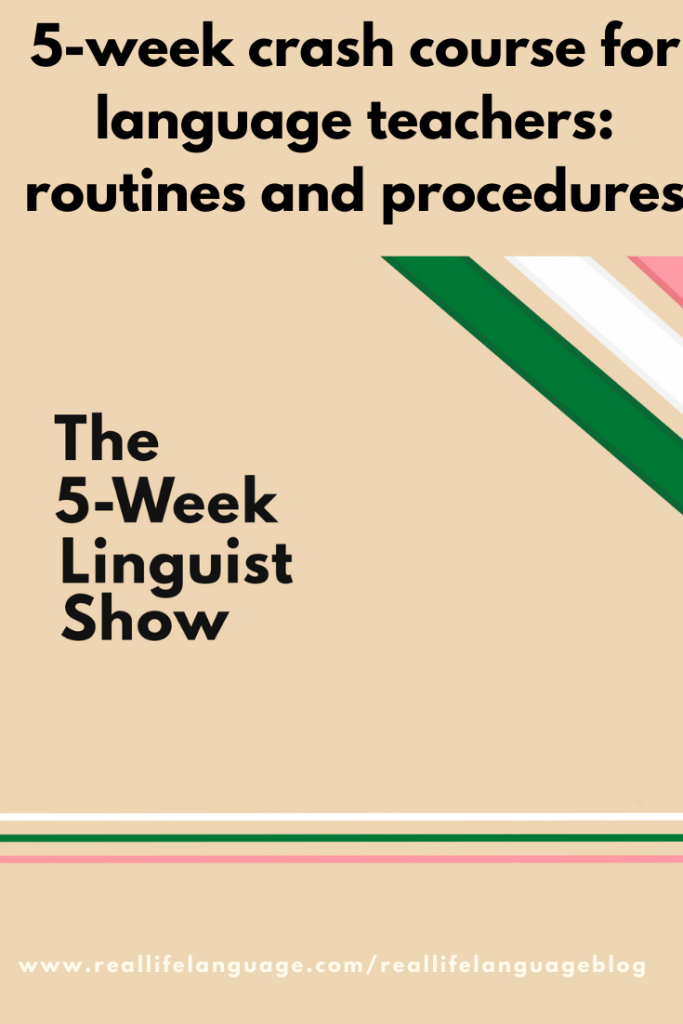
Welcome to the 5-Week Linguist Show. If you want to learn a language or you teach a language, you’ve come to the right place. Join Janina each week for tips, resources, and advice for making engaging language learning happen anytime, anywhere.
Welcome to the 5-Week Linguist Show. Over these five weeks, we’ve been talking a lot about starting the year as a language teacher, and I’ve been teaching for a lot of years. And the purpose of this is hopefully, you won’t make the same mistakes I did, and you’ll save yourself a lot of time, and things will go much more smoothly. And I hope that you benefit and find some takeaways to bring to your classroom. So the very first week in this series, we talked about Harry Wong and routines and procedures. And Harry Wong is the author of the First Days of School, and he talks a lot about routines and procedures, and he believes teachers should focus on routines and procedures for the first two weeks of school and not worry at all about content.
And the way I incorporated that, and I’ve really built on that over the years is through doing everything that needs to happen in my classroom that’s not instruction, not part of the course, necessarily, in this routine part of the lesson. And I’ve published lots of lessons throughout the years, and it will always say routines, routines, routines, routines, routines. And I don’t go into great detail, except for in the beginning of the year, I go into a lot of detail about what that means. And once we’ve incorporated them, we’re always doing them, but they could become kind of automatic. And so I wanted to talk about some of my routines at the beginning of the school year that you could use in any target language.
So I talked about the environment, about my word walls and building word walls of survival language. Again, a very simple, basic thing. But sometimes it’s, as Harry Wong argues, it’s those simple basic things that we forget sometimes, and they’re really just common sense and they make things go so much more easily. And I think he’s right. So, but some of the things I really write down in my lessons all the routines so I won’t forget to do any of them and then I can reduce how I treat this part of the lesson throughout the year. So apart from basic classroom commands, and can I go to the bathroom, yes/no, things like that. Some of the routines that I teach every day are the Pledge of Allegiance. And the Pledge of Allegiance is American English, but there’s a great deal of rich vocabulary that can be taught in lots of languages working in American school. And if you work in another country, I’m sure there’s something similar that you can do that would have just as much value.
And alternatively, I would also start class with some kind of target language culture that’s similar. But I really like to start class with the Pledge of Allegiance because it really helps them learn all that vocabulary. And I can also insert a lot of other vocabulary in there as well, so body parts, put your hand on your chest, that kind of thing, or put your hand on your heart, they know that stuff when you get to that part of the quote-unquote the book. So that’s one routine that I do.
I also practice classroom commands, so stand up, sit down. Teaching a language that has masculine and feminine and masculine and feminine together, it takes the masculine forms, I use a lot of visuals to teach the difference between when it’s just feminine, when it’s just masculine, and when it’s both. And so we do a lot of exercises understanding, stand up and sit down, girls stand up and sit down everybody, so that they understand the difference. And they ask, they ask about the grammar, “Well, wait a minute, that’s the same word.” And that’s exactly the point. That’s the step that we want them to do.
The other hugely critical piece that I do in my routines is the calendar. And when I taught kindergarten, I had the opportunity to work with some really amazing teachers who that portion of their day where they did the calendar every day was hugely impactful. And their calendar time, every day taught numbers, and patterns, and weather. And they had daily oral language, they all sat around and really talked about this calendar. And I used that in my classroom and I’ve used it for many years. You can talk about what day it is, the month, the season, how many days are in a week? What are the months of the year? I really embellish that part of the calendar.
I add on a new piece every day and until that’s just part of our routine where everybody can answer all the basic questions. They get to talk about the weather, they get to talk about the seasons, they’ve learned numbers zero, or actually, not zero, one through 30 or one through 31 very easily. And then zero is very easy to teach, cero in Spanish. They see the pattern. I write the day and the date on the board every day. And I really embellished that, adding a different piece of the calendar every single lesson until they get it. And then it becomes a quick exercise in the beginning.
Resources for teachers of ANY language: https://reallifelanguage.lpages.co/language-lessons-5-weeks-of-low-and-no-prep-fun/
Podcast: Play in new window | Download
Subscribe: RSS